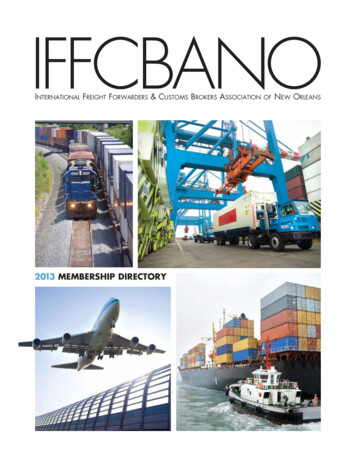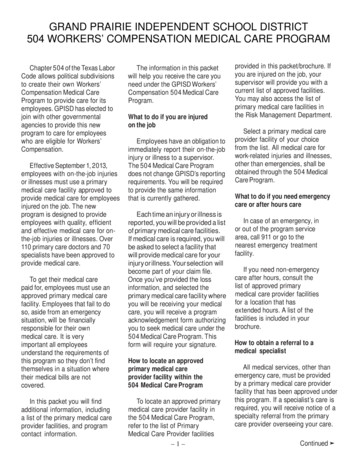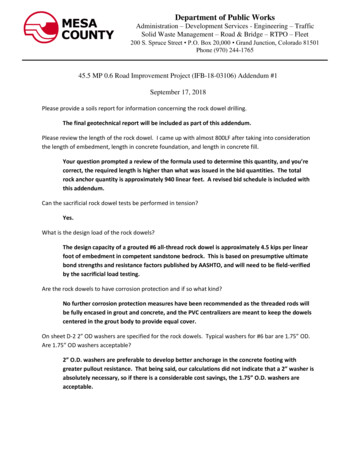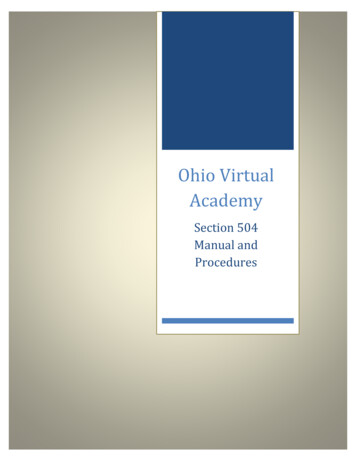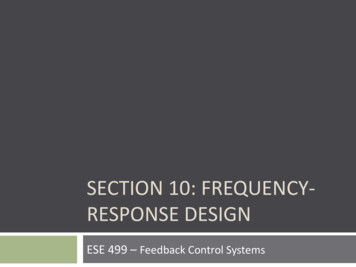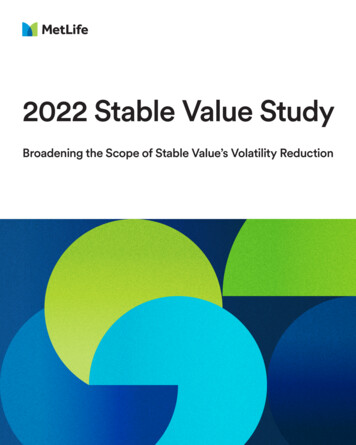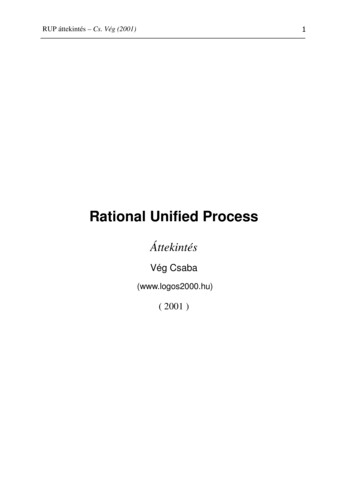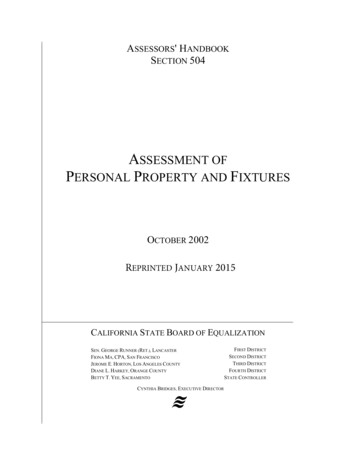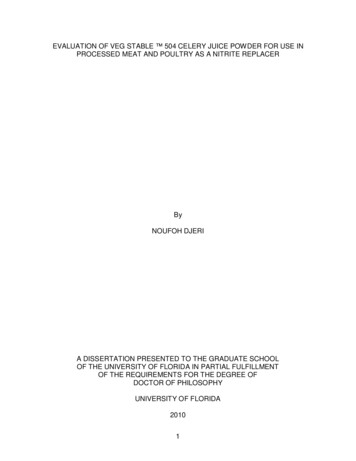
Transcription
EVALUATION OF VEG STABLE 504 CELERY JUICE POWDER FOR USE INPROCESSED MEAT AND POULTRY AS A NITRITE REPLACERByNOUFOH DJERIA DISSERTATION PRESENTED TO THE GRADUATE SCHOOLOF THE UNIVERSITY OF FLORIDA IN PARTIAL FULFILLMENTOF THE REQUIREMENTS FOR THE DEGREE OFDOCTOR OF PHILOSOPHYUNIVERSITY OF FLORIDA20101
2010 Noufoh Djeri2
To my family and friends- I could not have finished without your support.3
ACKNOWLEDGMENTSI would like to express my sincere appreciation and gratitude to my advisor, Dr.Sally K. Williams, for her guidance throughout my dissertation and graduate studies.Without her constant guidance, support and encouragement, the completion of myMaster of Science and Doctor of Philosophy degrees would not have been possible.I also extend my gratitude to Drs. James Bacus, Charles A. Sims, and Jean-PierreEmond, dissertation committee members, for their valuable counsel and guidance. I amalso grateful for the assistance of Dr. Jean-Claude Bonzongo for his continualencouragement, and in facilitating my use of his laboratory. I would like to thank Dr.Lokenga Badinga for sharing his expertise in statistics with me.I greatly appreciate Mike McIntyre from Florida Food Products, Inc. for hisassistance and for providing me with materials needed for my research. I thank theMeat Processing Center staff: Byron Davis, Tommy Estevez and all the student workersfor assisting me with the use of the facility. Thanks go out to Frank Robbins, Jr. whopassed away at the beginning of this year. His help and assistance in the laboratory willnot be forgotten. Without his support, this project would not have gone as smoothly.Special thanks go out to my parents (Amoye Djeri, and Koffi Djeri), brother (GbatiDjeri) and sisters (Ikpindi Djeri, and Adja Djeri) and my cousin (Enyonam Sossou) fortheir love, encouragement, moral support and patience throughout this process.Great appreciation goes to Dr. Angeleah Browdy, Dr. Ronald M. Gordon, TyrellKahan and Lemane Delva for your assistance. I also am appreciative of DesireDjidonou for being a friend and aiding me with statistics.Finally, thanks go out to my adoptive moms Erma Young-Certain, Henrola London,Yvette Zie-Bonzongo and Antoinette D’Assomption for their moral support and love.4
TABLE OF CONTENTSpageACKNOWLEDGMENTS . 4LIST OF TABLES . 8LIST OF FIGURES . 10ABSTRACT. 11CHAPTER1INTRODUCTION . 142REVIEW OF LITERATURE . 17History of Curing . 17Chemistry of Meat Color . 17Meat Curing . 19Synthetic and Natural Nitrite. 19Choice of Celery Powder . 20Nitrites and Cured Meat. 21Functions of Nitrite and Factors Affecting Residual Nitrite. 23Regulations and Hazards . 24Vacuum-Packaged Cooked Cured Meat . 27Clostridium botulinum . 29Spoilage of Vacuum-packaged Cooked Cured Meat . 32General Characteristics . 32Spoilage from Lactic Acid Bacteria (LAB) . 33Application of Natural Ingredients as Nitrite Replacers . 35New Generation of Meat Products. . 35Natural Products . 35Nitrates in Vegetables . 36Natural Curing . 363EVALUATION OF ANTIMICROBIAL PROPERTIES OF CELERY JUICEPOWDER CONTAINING PRE-GENERATED NITRITE ON CLOSTRIDIUMBOTULINUM IN DIFFERENT CONDITIONS . 40Introduction . 40Materials and Methods . 42Sample Preparation . 42Products . 43Preparation of Inoculum . 43Rcm broth . 43Experiments . 435
Media and spore inoculum. . 45Results and Discussion . 45Conclusion . 494EFFECT OF HOLDING TIME ON COLOR, PH AND RESIDUAL NITRITE OFBEEF FRANKFURTERS FORMULATED WITH EITHER CELERY POWDEREXTRACT WITH PRE-GENERATED NITRITE OR COMMERCIALLYAVAILABLE SODIUM NITRITE . 54Introduction . 54Materials and Methods . 56Shelf Life Evaluation . 56Experimental Design . 57Processing . 57Chemical Analysis . 58Color Measurement . 58pH Analysis . 58Nitrite Analysis for Celery Powder . 58Residual Nitrite Content . 59Statistical Analysis . 61Result and Discussion . 62Objective Color Analyses . 62pH and Residual Nitrite Analyses . 63Conclusions . 655EVALUATION OF SLICED VACUUM PACKAGED TURKEY BOLOGNACONTAINING DIFFERENT LEVELS OF CELERY JUICE POWDER STOREDAT 4 1 C FOR 10 WEEKS UNDER RETAIL DISPLAY LIGHT . 70Introduction . 70Materials and Methods . 72Product Manufacturing . 72Proximate Composition . 73Color Measurement . 73pH Determination . 73TBARS Analysis . 74Consumer Sensory Panel . 74Microbiological Analyses . 75Statistics . 76Results and Discussion . 76Proximate Composition . 76Thiobarbituric Acid Reactive Substances (TBARS) . 77pH Analysis . 77Objective Color Analyses . 78Microbiology . 81Conclusion . 856
6GENERAL CONCLUSION . 99APPENDIXAVEGETABLE JUICE POWDER PRODUCT INFORMATION (FLORIDA FOODPRODUCTS, INC.) . 101BCONSUMER SENSORY EVALUATION RESPONSES . 112LIST OF REFERENCES . 119BIOGRAPHICAL SKETCH. 1297
LIST OF TABLESTablepage2-1Maximum ingoing nitrite and nitrate limits (in ppm) for meat and poultryproducts. . 263-1Clostridium. botulinum spore counts in Reinforced Clostridium broth withdifferent levels of Veg Stable 504 (pre-generated nitrite) and Veg Stable 515 (ascorbic acid) and no turkey bologna mixture added . 503-2.Clostridium. botulinum spore counts in turkey bologna emulsion with differentlevels of Veg Stable 504 (pre-generated nitrite) and Veg Stable 515(ascorbic acid) . 503-3Clostridium. botulinum spore counts in turkey bologna type emulsion withdifferent levels of Veg Stable 504 (pre-generated nitrite), and Veg Stable 515 (ascorbic acid) cultured on Shahidi-Ferguson Perfringens agar . 513-4Clostridium. botulinum spore counts in Reinforced Clostridium broth withdifferent levels of Veg Stable 504 (pre-generated nitrite) and Veg Stable 515 (ascorbic acid) and no turkey bologna mixture added * . 514-1Mean L* values (Lightness) for beef frankfurters containing celery powderand modern cure . 684-2Mean a* values (Redness) for beef frankfurters containing celery powder andmodern cure . 684-3Mean b* values (Yellowness) for beef frankfurters containing celery powderand modern cure . 684-4Mean pH values for beef frankfurters containing celery powder and moderncure . 694-5Mean Residual Nitrite values for beef frankfurters containing celery powderand modern cure . 695-1Turkey bologna formulation containing different levels of Veg Stable 504,Veg Stable 515, and modern cure . 875-2Turkey bologna seasoning formulation . 885-3Smokehouse cooking schedule for Turkey bologna . 885-4Chemical composition of the different formulations of bologna . 888
5-5Least square means for the interactions of treatment combined storage timefor Thiobarbituric acid reactive substances (TBARS) in turkey bologna . 895-6Least square means for the interactions of treatment combined storage timefor pH in turkey bologna . 905-7Least square means for the interactions of treatment combined storage timefor L* values in direct contact with the slice exposed to light and of 2nd slicedirectly below the one exposed to light in turkey bologna . 915-8Least square means for the interactions of treatment combined storage timefor a* values in direct contact with the slice exposed to light and of 2nd slicedirectly below the one exposed to light in turkey bologna . 925-9Least square means for the interactions of treatment combined storage timefor b* values in direct contact with the slice exposed to light and of 2nd slicedirectly below the one exposed to light in turkey bologna . 935-10Least square means for the interactions of treatment combined storage timefor Aerobic counts in turkey bologna . 945-11Least square means for the interactions of treatment combined storage timefor Anaerobic counts in turkey bologna . 955-12Least square means for the interactions of treatment combined storage timefor Lactic acid bacteria counts in turkey bologna . 965-13Least square means for the interactions of treatment combined storage timefor Psychrotrophic counts in turkey bologna . 975-14Least square means for the interactions of treatment combined storage timefor sensory attributes of turkey bologna . 989
LIST OF FIGURESFigurepage2-1Scheme of the proposal of Hoagland (1910, 1914) for the action of nitrate incured meat products (Adapted from Honikel (2008)). 192-2Manufacturing of Sodium Nitrite, adapted from Greenwood and Earnshaw(1998). 202-3Curing Agent Calculation (Adapted for the USDA Processing Inspector’sCalculations Handbook, 1995). 2710
Abstract of Dissertation Presented to the Graduate Schoolof the University of Florida in Partial Fulfillment of theRequirements for the Degree of Doctor of PhilosophyEVALUATION OF VEG STABLE 504 CELERY JUICE POWDER FOR USE INPROCESSED MEAT AND POULTRY AS NITRITE REPLACERByNoufoh DjeriAugust 2010Chair: Sally Kathryn WilliamsMajor: Animal SciencesThe objectives of this research were to determine the composition of Veg Stable 504 celery juice powder containing pre-generated nitrite (CJPPN ) and monitor its shelflife for six months; to determine the effectiveness of different levels of CJPPN againstClostridium botulinum in a turkey bologna system formulated with synthetic sodiumnitrite (also referred to as modern cure or prague powder); to evaluate the effect ofholding time, prior to heat processing, on the color, pH, and residual nitrite of beeffrankfurters using different levels of the CJPPN; and to ascertain the effects of CJPPNon objective color, pH, quality attributes and consumer acceptance and microbiology ofvacuum packaged turkey bologna over an extended storage time.C. botulinum spores tested on a bologna type emulsion product containing either acombination of 0.20% Veg Stable 504, and 0.20% Veg Stable 515 (cherry powderused to replace synthetic sodium erythorbate), and modern cure (commerciallyavailable nitrite) combined with sodium erythorbate showed 1- 3 log reduction over 48hours, while a 3 log increase was observed for 0.20% Veg Stable 504 withoutexhibition of any spoilage or off odor in the meat product. Modern cure used alone or in11
conjunction with sodium erythorbate revealed a 2 log reduction over 48 hours in RCM(Reinforced Clostridial Media), while 156 ppm Veg Stable 504, and 156 ppm VegStable 504 and 469 ppm Veg Stable 515 experienced a 3 log reduction. RCM brothdid not support the growth of C. botulinum. Over 48 hours, 156 ppm Veg Stable 504and 156 ppm Veg Stable 504 and 469 ppm Veg Stable 515 experienced 1 logdecrease regarding C. botulinum spore counts when compared to modern cure aloneand with ascorbic acid.The usage of different levels of CJPPN to evaluate the effect of holding time onthe color, pH, and residual nitrite in beef frankfurters showed some promising results. Alltreatments had similar (P 0.05) pH, L* and b* values. The a* values for the control(modern cure) were higher (P 0.05) than 0.20% celery powder as holding timeincreased. The different treatments of Veg Stable 504 (0.20%, 0.30%, and 0.40%)were shown to be comparable to traditionally cured frankfurters, in regards to L*, b*, andpH values. The a* values for the traditionally cured beef frankfurter was overall redderthan the frankfurters containing celery juice powder. The control had significantly higherlevels of residual nitrite (P 0.05) when compared to 0.20, 0.30, 0.40 % celery juicepowder. Less residual nitrite was present in the beef frankfurters manufactured usingdifferent levels of Veg Stable 504 at 0.20, 0.30, and 0.40%. As the celery juicepowder usage level increased from 0.20% to 0.40%, the more residual nitriteconcentration also increased, but remained significantly less (P 0.05) than the control(modern cure).The consumer sensory panel evaluated turkey bologna manufactured with 0.20%Stable 504, 0.20% Stable 504 0.20% Veg Stable 515, 156 ppm Stable 504 12
469 ppm Veg Stable 515, and 156 ppm Prague powder 550 ppm of sodiumerythorbate. The panelists reported that the turkey bologna manufactured with celerypowder juice containing the pre-generated sodium nitrite had a comparableappearance, aroma, texture, and flavor as the products cured with synthetic sodiumnitrite (P 0.05). The exception was the product that contained ten times therecommended usage level (156 ppm Stable 504 469 ppm Veg Stable 515), andwas not well liked by the consumer panelists. In addition, no pathogenicmicroorganisms were detected. Veg Stable 504 could successfully be used fornaturally cured meat products if the levels of nitrite are increased (use as preservative).13
CHAPTER 1INTRODUCTIONConsumers have been making more health conscious food choices over theyears. The meat industry has taken advantage of this opportunity and tried to satisfy itsconsumers. A variety of products that include claims such as uncured, natural, organic,no preservatives, minimally processed are offered to consumers at the retail level.Products offered range from fresh to processed food products, and consumers havebeen flooded and confused by the different claims.Treating meat with chemical compounds such as salt, nitrate/ nitrite, spices, andphosphates has resulted in cured meat products. Curing is a method of preservationthat dated back to the twelfth centuries B.C., with salt as the main ingredient. Desirablechanges in the products were noticed and attributed to nitrite in the 19th century. Inaddition to being recognized as an important ingredient in the curing process, nitrite hasfour main functions: stabilization of the color of the lean tissues, characteristic flavor ofcured meat, retardation of fat oxidation, and inhibition of several pathogenic andspoilage organisms (such as Clostridium, Bacillus, Pseudomonas, and Salmonella).The use of nitrite in cured meat has become controversial because of potentialnitrosamine formation from nitrite, which are suspected of being carcinogens. Aftermuch research was conducted on nitrosamines and carcinogenicity of nitrites, nocorrelations were found between the consumption of cured meat products by humansand cancer.Consumers are still distrustful of nitrites, leading to the development of alternativemethods to cure meat. New sources of nitrate/nitrite have been found, and used in meatproducts to satisfy consumers’ needs for natural, no preservative added items. There14
are cured meat products available at the retail level labeled “uncured, nonitrates/nitrates added” that have some of the nitrite cured products characteristics. TheUnited States Department of Agriculture (USDA) allows meat products whichconventionally contain nitrates or nitrites to be manufactured without nitrates or nitrites.Consequently, these specific meat products need to be labeled as “Uncured” followingthe common, descriptive name with disclaimers including “No Nitrate or Nitrite Added”(Code of Federal Regulations Title 9, Part 317.17 and 319.2 (CFR, 2010).Uncured products are separated into two categories: uncured with no intention ofreplacing nitrate or nitrite (uncured) and uncured with the intention of replacing nitrate ornitrite (naturally cured). Despite the fact that “natural curing” is not officially defined bythe USDA, it refers to curing that result from the microbial conversion of nitrates tonitrites with similar characteristics to the direct addition of synthetic nitrite. Ingredientscontaining nitrate or nitrite (such as sea salts, green plants, and vegetables) are neededto manufacture such products. Some vegetable sources containing significantconcentrations of nitrates (celery powder specifically), in combination with nitratereducing starter culture are used for the production of naturally cured meat products.Quality attributes and consumer acceptance of uncured, no nitrate/nitrite addedcommercial hams, bacons, and frankfurters were evaluated and compared to meatproducts cured with synthetic nitrite. Hams were comparable in color, residualnitrate/nitrite, total and cured pigments, lipid oxidation, and accepted by consumers.Frankfurters showed some variation in the amount of curing reactions, and a slightdifference regarding consumer sensory attributes (Sindelar et al., 2007).15
When using vegetable juice powder in meat products, nitrate-reducingmicroorganisms must be utilized. Even though the pre-generated nitrite from celery juicepowder should be similar to the synthetic nitrite, little is known on how its productscompare to the traditional nitrite added products.As a result, incubation time is needed to allow the curing to occur, whichconsumes time. The hypothesis for this project is that there are no differences betweenproducts cured with commercially available sodium nitrite (modern cure) and uncuredproducts with the intention of replacing sodium nitrite, using celery juice powdercontaining pre-generated nitrite (CJPPN). Regardless of its source, nitrite shouldchemically react the same manner to cure meat products.Consequently the objectives of this research were to determine the composition ofCJPPN and monitor its shelf life for six months; to determine the effectiveness ofdifferent levels of CJPPN against Clostridium botulinum in a turkey bologna systemformulated with synthetic sodium nitrite (also referred to as modern cure or praguepowder); to evaluate the effect of holding time, prior to heat processing, on the color,pH, and residual nitrite of beef frankfurters using different levels of the CJPPN; and toascertain the effects of CJPPN on objective color, pH, quality attributes and consumeracceptance and microbiology of vacuum packaged turkey bologna over an extendedstorage time.16
CHAPTER 2REVIEW OF LITERATUREHistory of CuringCuring meat is defined as the addition of nitrite and or nitrate and salt (NaCl) tomeat at different stages of preparation for processing (Honikel, 2007). This particulartechnique is very ancient and has been used for centuries. The preservation of fishusing salt can be traced back to 3500 B.C. Salt containing nitrates was used in Homer’sOdyssey around eight century B.C. for meat preservation ( Kramlich et al., 1973;Pearson and Tauber, 1984). Meat products dried with salt were inconsistent in theirquality and appearance. It was observed that a certain type of salt was at the origin ofthe change in the desired meat color. The appealing and preservative characteristics ofsaltpeter or potassium nitrate were understood in the late 19th century, with the changein color attributed to nitrate impurities. Reduction activities occurring in the muscletissues postmortem were responsible for the conversion from nitrate to nitrite, resultingin curing (Pegg and Shahidi, 2004). The reduction of nitrite to nitric oxide and nitrousacid was found by Haldane (1901) and Hoagland (1908) to be cured meat red color. In1925, the United States Department of Agriculture (USDA) authorized the use of sodiumnitrite for meat curing after extensive research. This critical ingredient was found to haveseveral functions, and included color stabilization, characteristic color and flavor, andantimicrobial properties against pathogenic (Clostridium botulinum spores) and spoilagemicrobes (Pearson and Tauber, 1984; Aberle et al., 2001; Russell et al., 2003).Chemistry of Meat ColorColor is one of the most important factors consumers consider when purchasingmeat products (Shahidi, 1998; Aberle et al., 2001). Myoglobin, an atom composed of a17
complex of pyrrole rings, is the red pigment that is at the origin of meat’s color. In thelast few decades, extensive research has been conducted on nitrite and meat pigments,mainly myoglobin. This particular pigment has the ability to lose or gain electrons andalso bind to different chemicals. Several factors such as species, maturity or age,muscle physical activity, and environment affect myoglobin (which constitutes 80 to 90%of the total red meat pigments) concentrations in muscles (Forrest et al., 1975). Meatcolor varies from purplish- red for freshly cut beef to a light gray color for faded pork.Oxymyoglobin (oxygen combined to myoglobin) and myoglobin when oxidized, lose anelectron, resulting in metmyoglobin (a brown color). Myoglobin is readily converted tooxymyoglobin (oxidation), or to metmyoglobin (oxidation). The conversion ofmetmyoglobin back to myoglobin or oxymyoglobin through oxidation is more difficult.Besides oxygen, other chemicals such as nitric oxide can also bind to myoglobin ormetmyoglobin. Nitrososomyoglobin, a red pigment (the result of nitric oxide binding tomyoglobin or metmyoglobin), is unstable but is rendered stable by heat (Rust, 1980).Cured meat pigment is named nitrosohemochrome, and is pink in color.Cassens et al. (1979) found that when nitrite is in a meat mixture, it oxidizesmyoglobin to metmyoglobin (a grayish brown color). Nitric oxide and nitrous acid areformed as the nitrite from sodium nitrite interacts with water to form nitric oxidemyoglobin. Meat pigments (specifically myoglobin) react with nitrite to form an unstablepink color (Russell and Gould, 2003). After application of a heat treatment (cooking),this pigment is stable and is known as nitrosylhemochrome (cured pigment), which islight, temperature, and oxygen sensitive (Hornsey, 1956; Rust, 1980; O’Boyle et al.,1990; Boles and Pegg, 2005).18
Meat CuringChemical reactions occurring during curing of meat was detailed by Haldane(1901), demonstrating the result of red-ox reactions and NO-myoglobin attributed thecharacteristic red colour (Honikel, 2008). The reactant was found to be nitrite anion withnitrous acid (HNO2) or nitric oxide (NO) reacting with the myoglobin (Honikel, 2008).Curing reactionNitrateNitrite (reduction by starter culture)KNO2 H HNO2 K 2HNO2N2O3 H2ON2O3NO NO2NO myoglobinNO-myoglobinFigure 2-1. Scheme of the proposal of Hoagland (1910, 1914) for the action of nitrate incured me
than the frankfurters containing celery juice powder. The control had significantly higher levels of residual nitrite (P 0.05) when compared to 0.20, 0.30, 0.40 % celery juice powder. Less residual nitrite was present in the beef frankfurters manufactured using different levels of Veg Stable 504 at 0.
